| Srl | Item |
| 1 |
ID:
093339
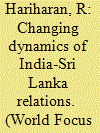

|
|
|
|
|
| Publication |
2009.
|
| Summary/Abstract |
The defeat of the Liberation Tigers of Tamil Eelam (LTTE) and the elimination its founder-leader velupillai Prabhakaran along with the entire leadership in May 2009 brought the curtains down on Tamil insurgency in Sri Lanka, at least for the time being.
|
|
|
|
|
|
|
|
|
|
|
|
|
|
|
|
| 2 |
ID:
131377
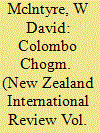

|
|
|
| 3 |
ID:
117808
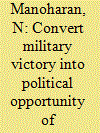

|
|
|
| 4 |
ID:
189713
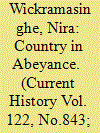

|
|
|
|
|
| Summary/Abstract |
Amid an economic meltdown in 2022, a nonviolent citizens movement in Sri Lanka ousted Prime Minister Mahinda Rajapaksa and President Gotabaya Rajapaksa, brothers from a family that had dominated national politics since 2005. But Parliament filled the presidential vacancy with Ranil Wickremesinghe, a six-time former prime minister seen as a proxy for his predecessors. After a draconian crackdown on protesters, the streets have quieted. But the country’s underlying economic and political crisis, which has roots in the early postcolonial period and the civil war, and was worsened by the Rajapaksas’ autocratic misrule, persists. The new administration has avoided the systemic change demanded by protesters.
|
|
|
|
|
|
|
|
|
|
|
|
|
|
|
|
| 5 |
ID:
093940
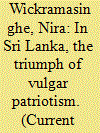

|
|
|
|
|
| Publication |
2010.
|
| Summary/Abstract |
Rajapaksa's patriotism merges nation and state, and it promotes a love of country based on a particular reading of the Sinhalese people's foundation myth, a reading in which all other groups . . . are present only as shadows.
|
|
|
|
|
|
|
|
|
|
|
|
|
|
|
|
| 6 |
ID:
118501
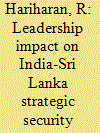

|
|
|
| 7 |
ID:
115907
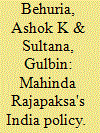

|
|
|
|
|
| Publication |
2013.
|
| Summary/Abstract |
Mahinda Rajapaksa has emerged as perhaps the only Sri Lankan leader who has managed to secure some strategic autonomy in conducting his country's foreign policy vis-à-vis India. He engaged India effectively during the military campaign against the Liberation Tigers of Tamil Eelam (LTTE) and simultaneously countervailed India by improving his country's relationship with India's traditional adversaries such as China and Pakistan. In the post-LTTE scenario, he has maintained a defiant posture vis-à-vis India over the latter's persuasion to evolve a political solution to the ethnic issue. Backed by a nationalist upsurge at home and support from countries such as China, he may continue with his policy of bypassing Indian pressures and persuasions in the coming days. Against this backdrop, the article raises the following questions and seeks to answer them. Does Rajapaksa's India policy signify a typical quest for strategic autonomy by a smaller state vis-à-vis a larger neighbour? Can this be explained as an effort to offset India's overwhelming influence on Sri Lanka? How is his 'India policy' different from that of other leaders? Does he display a unique style of leadership compared to his predecessors? How far has he succeeded in counterbalancing Indian influence? What are the reasons for his success or failure? What are the implications for India and how can he be effectively engaged?
|
|
|
|
|
|
|
|
|
|
|
|
|
|
|
|
| 8 |
ID:
175375


|
|
|
|
|
| Summary/Abstract |
Challenges to India’s foreign policy largely keeps emanating from the neighbourhood. Sri Lanka, like most other neighbours, has been a great cause of concern for Indian foreign policy makers. India’s neighbours have been found vulnerable to China’s growing influence in the region and Sri Lanka is no exception to it.
|
|
|
|
|
|
|
|
|
|
|
|
|
|
|
|
| 9 |
ID:
152264
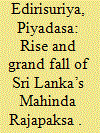

|
|
|
|
|
| Summary/Abstract |
Mahinda Rajapaksa became the president of Sri Lanka in 2005 and ruled the country until his unexpected defeat in the presidential election of 2015. He crushed the militant and very powerful Tamil separatist group, the Liberation Tigers of Tamil Eelam, by military force in 2009. Given his great power and popularity, his defeat in the 2015 election was an astonishing grand fall. This study examines the long rise of Mahinda Rajapaksa and his sudden fall.
|
|
|
|
|
|
|
|
|
|
|
|
|
|
|
|
| 10 |
ID:
117809


|
|
|
| 11 |
ID:
086679
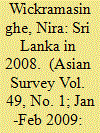

|
|
|
|
|
| Publication |
2009.
|
| Summary/Abstract |
The year 2008 saw a successful military campaign by government security forces against the Liberation Tigers of Tamil Eelam (LTTE) in the North. Elections to the Eastern Province resulted in a break away faction of the LTTE sharing power with the government. People continued to endure high inflation in the price of essential goods and services, and the country's human rights record remained dismal.
|
|
|
|
|
|
|
|
|
|
|
|
|
|
|
|
| 12 |
ID:
130204
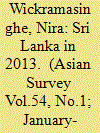

|
|
|
|
|
| Publication |
2014.
|
| Summary/Abstract |
The year 2013 witnessed a further consolidation of the power of President Mahinda Rajapaksa and his loyalists of the ruling United People's Freedom Alliance. The country's high economic growth continued amid allegations of corruption and nepotism. The regime's past and present human rights record came under serious scrutiny.
|
|
|
|
|
|
|
|
|
|
|
|
|
|
|
|
| 13 |
ID:
137901
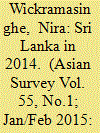

|
|
|
|
|
| Summary/Abstract |
The year 2014 witnessed a few cracks in the government of the United People’s Freedom Alliance in the face of internal and external challenges. Still, anti-Muslim violence, setbacks in provincial elections, and mounting concerns over the coalition’s human rights record failed to disrupt continued high economic growth. The surprise was the January 8, 2015, election: defeating the incumbent, on January 9, former Health Minister Maithripala Sirisena was sworn in as Sri Lanka’s new president.
|
|
|
|
|
|
|
|
|
|
|
|
|
|
|
|
| 14 |
ID:
145452
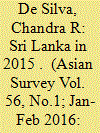

|
|
|
|
|
| Summary/Abstract |
The year 2015 in Sri Lanka was characterized by a democratic transfer of power from the United People’s Freedom Alliance, led by President Mahinda Rajapaksa, to a coalition led by the United National Party. Constitutional changes restricting presidential power, and the growth of a new approach to human rights and ethnic reconciliation, accompanied this shift. Sri Lanka’s emphasis in its economic policy shifted from major infrastructural projects to a further strengthening of human capacities.
|
|
|
|
|
|
|
|
|
|
|
|
|
|
|
|
| 15 |
ID:
152242
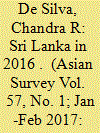

|
|
|
|
|
| Summary/Abstract |
In 2016 Sri Lanka saw political stability and some initiatives toward ethnic reconciliation. The economy continued to grow steadily. Some progress was made toward a better institutional infrastructure to protect human rights. However, hostility between President Sirisena and loyalists to former President Rajapaksa presages political turmoil in 2017 that could imperil constitutional reform and ethnic reconciliation.
|
|
|
|
|
|
|
|
|
|
|
|
|
|
|
|
| 16 |
ID:
117811
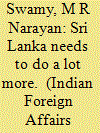

|
|
|
| 17 |
ID:
117807
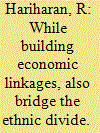

|
|
|
| 18 |
ID:
096321
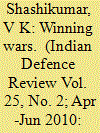

|
|
|